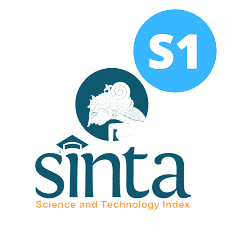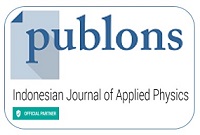Structural Optimization of Hydrogenated Amorphous Silicon Layers for Enhanced Solar Cell Efficiency
Abstract
Energy conversion efficiency of hydrogenated amorphous silicon (a-Si: H) based solar cells remains a major challenge in the development of renewable energy technologies. One approach to improve this efficiency is through improving the solar cell layer structure. This research aims to maximize the layer structure of a-Si: H solar cells by using OghmaNano software simulation. This simulation allows in-depth analysis of the effect of bandgap variation as well as layer thickness on solar cell performance. The method used in this research is to perform numerical simulations using OghmaNano software. The a-Si: H solar cell model was built by varying relevant parameters such as substrate (glass), ITO, p i n layer, and metal contacts. Simulations were performed to obtain the I-V characteristics of the solar cell, which were then used to calculate the energy conversion efficiency. The simulation results were analyzed to identify the layer structure configuration that yielded the highest efficiency. The results hypothesize that determining the layer structure of a- Si: H solar cells can significantly improve the energy conversion efficiency. Variations in intrinsic layer thickness and bandgap have a significant effect on solar cell performance. With variations in layer thickness and bandgap, it is expected to maximize light absorption and increase energy conversion efficiency, which will significantly improve the overall performance of solar cells.
Keywords
Full Text:
PDFReferences
1 Ghannam, M. & Abdulraheem, Y. Fundamental constraints imposed by energy barriers on the fill factor and on the efficiency of silicon heterojunction solar cells. Solar Energy Materials and Solar Cells 171, 228–238 (2017).
2 Sultana, B. et al. A novel design and optimization of Si based high performance double absorber heterojunction solar cell. Materials Science and Engineering: B 304, 117360 (2024).
3 Azad, M. L. et al. An efficient Mppt approach of PV systems: incremental conduction pathway. Indonesian Journal of Electrical Engineering and Computer Science 15, 1189–1196 (2019).
4 Hamdani, D., Prayogi, S., Cahyono, Y., Yudoyono, G. & Darminto, D. The influences of the front work function and intrinsic bilayer (i1, i2) on p-i-n based amorphous silicon solar cell’s performances: A numerical study. Cogent Engineering 9, 2110726 (2022).
5 Hamdani, D., Prayogi, S., Cahyono, Y., Yudoyono, G. & Darminto, D. The Effects of Dopant Concentration on the Performances of the a-SiOx:H(p)/a-Si:H(i1)/a-Si:H(i2)/µc-Si:H(n) Heterojunction Solar Cell. International Journal of Renewable Energy Development 11, 173–181 (2022).
6 Prayogi, S., Cahyono, Y., Iqballudin, I., Stchakovsky, M. & Darminto, D. The effect of adding an active layer to the structure of a-Si: H solar cells on the efficiency using RF-PECVD. J Mater Sci: Mater Electron 32, 7609–7618 (2021).
7 Prayogi, S. et al. Observation of resonant exciton and correlated plasmon yielding correlated plexciton in amorphous silicon with various hydrogen content. Sci Rep 12, 21497 (2022).
8 Hawas, M. N., Hasan, I. J. & Mnati, M. J. Simulation and analysis of the distributed photovoltaic generation systems based on DIgSILENT power factory. Indonesian Journal of Electrical Engineering and Computer Science 28, 1227–1238 (2022).
9 Singh, S., Kumar, S. & Dwivedi, N. Band gap optimization of p–i–n layers of a-Si:H by computer aided simulation for development of efficient solar cell. Solar Energy 86, 1470–1476 (2012).
10 Ghannam, M., Abdulraheem, Y. & Shehada, G. Interpretation of the degradation of silicon HIT solar cells due to inadequate front contact TCO work function. Solar Energy Materials and Solar Cells 145, 423–431 (2016).
11 Rawat, A., Sharma, M., Chaudhary, D., Sudhakar, S. & Kumar, S. Numerical simulations for high efficiency HIT solar cells using microcrystalline silicon as emitter and back surface field (BSF) layers. Solar Energy 110, 691–703 (2014).
12 Khudhair, A. M., Ben Ahmed, A., Ajeel, F. N. & Mohammed, M. H. Theoretical investigation on the therapeutic applications of C2B and C2O as targeted drug delivery systems for hydroxyurea and 6-thioguanine in cancer treatment. Nano-Structures & Nano-Objects 38, 101135 (2024).
13 Minemoto, T. et al. Theoretical analysis of band alignment at back junction in Sn–Ge perovskite solar cells with inverted p-i-n structure. Solar Energy Materials and Solar Cells 206, 110268 (2020).
14 Soldera, M., Koffman-Frischknecht, A. & Taretto, K. Optical and electrical optimization of all-perovskite pin type junction tandem solar cells. J. Phys. D: Appl. Phys. 53, 315104 (2020).
15 Sugiura, T. & Nakano, N. Review: Numerical simulation approaches of crystalline-Si photovoltaics. Energy Science & Engineering 11, 3888–3906 (2023).
16 Prayogi, S., Kresna, Cahyono, Y., & Darminto. Electronic structure of P-type amorphous silicon nanowires. Phys. Scr. 98, 105954 (2023).
17 Song, J. et al. Degradation of electrical characteristics in low-bandgap polymer solar cells associated with light-induced aging. Organic Electronics 81, 105686 (2020).
18 Khan, S. N. et al. Predicting structural, elastic, and optoelectronic properties of oxide perovskites HfXO3 (X =Be, Mg) employing the DFT approach. Optik 303, 171724 (2024).
19 Kim, K.-H., Johnson, E. V., Kazanskii, A. G., Khenkin, M. V. & Roca i Cabarrocas, P. Unravelling a simple method for the low temperature synthesis of silicon nanocrystals and monolithic nanocrystalline thin films. Sci Rep 7, 40553 (2017).
20 Fatima Rasheed, J. & Suresh Babu, V. p+aSixC1-x: H/i-aSi:H/n+aSi1-xGex:H graded band gap single junction solar cell with composition graded amorphous silicon carbon alloy as window layer. Materials Today: Proceedings 39, 1910–1915 (2021).
21 Taliashvili, Z. et al. Optical properties of periodically and aperiodically nanostructured p-n junctions. Opt Quant Electron 55, 1028 (2023).
22 Braun, J. L. et al. Hydrogen effects on the thermal conductivity of delocalized vibrational modes in amorphous silicon nitride Phys. Rev. Mater. 5, 035604 (2021).
23 Huang, C.-C. et al. Band-Gap Tunability in Partially Amorphous Silicon Nanoparticles Using Single-Dot Correlative Microscopy. ACS Appl. Nano Mater. 4, 288–296 (2021).
24 Orapunt, F. & O’Leary, S. K. Optical transitions and the mobility edge in amorphous semiconductors: A joint density of states analysis. Journal of Applied Physics 104, 073513 (2008).
25 Prayogi, S., Cahyono, Y., & Darminto. Fabrication of solar cells based on a-Si: H layer of intrinsic double (P-ix-iy-N) with PECVD and Efficiency analysis. J. Phys.: Conf. Ser. 1951, 012015 (2021).
Refbacks
- There are currently no refbacks.
















